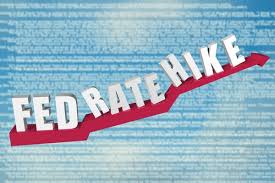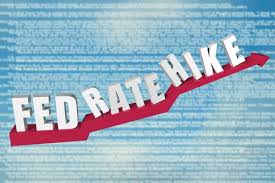
Slowing inflation in the United States may have allowed the Federal Reserve to slow the pace of future interest rate hikes, but policymakers have made it clear that they will continue to tighten monetary policy until price pressures are entirely broken.
A Labor Department report released Wednesday showing that consumer prices did not rise at all in July compared to June was just one step in what policymakers said would be a long process, with a red-hot job market and suddenly buoyant equity prices indicating that the economy requires more of the cooling that higher borrowing costs would provide.
Despite "positive" news in the labour market, Minneapolis Federal Reserve Bank President Neel Kashkari said at the Aspen Ideas Conference that the Fed is "far, far from declaring victory" on inflation.
Kashkari stated that he hasn't "seen anything that changes" the need for the Fed to raise its policy rate to 3.9 per cent by the end of the year and 4.4% by the end of 2023.
The rate is presently between 2.25 per cent and 2.5 per cent.
To be sure, Kashkari is the Fed's most hawkish member; nonetheless, the majority of his 18 colleagues believe that a little less policy tightening may be enough to bring prices under control.
In an interview with the Financial Times, San Francisco Fed President Mary Daly also warned that it is far too early for the US central bank to "declare triumph" in its fight against inflation.
According to the report, Daly stated that a half-point rate hike was her "baseline," but she did not rule out a third consecutive 0.75% point rate hike at the central bank's next policy meeting in September.
Inflation is "unacceptably" high, according to Chicago Fed President Charles Evans, who believes the Fed will need to raise its policy rate to 3.25 per cent-3.5 per cent this year and to 3.75 per cent-4 per cent by the end of next year, as Fed Chair Jerome Powell warned following the Fed's most recent meeting in July.
Nonetheless, he said, the CPI report represents the first "positive" estimate on inflation since the Fed began hiking interest rates in March in increasing chunks – a quarter of a percentage point at first, then a half-point, and then three-quarters of a point in both June and July.
Following Wednesday's CPI report, traders of futures linked to the Fed's benchmark interest rate reduced their bets on a third consecutive 75-basis-point boost at the Fed's September 20-21 policy meeting, with a half-point increase now seen as more plausible.
Equity markets followed suit, with the S&P 500 jumping 2.1 per cent on anticipation for a less aggressive central bank.
Financial markets are presently pricing in a top fed funds rate of 3.75% by year's end, with rate decreases following next year, presumably to counteract economic weakness.
Kashkari dismissed that prospect, saying Fed policymakers are "unified" in their commitment to reduce inflation to the Fed's 2 per cent target. The possibility of a recession "will not stop me" from arguing for what is required, he said.
In order for the Fed to soften, new inflation data must reinforce the premise that price increases are decreasing.
According to the statistics released on Wednesday, the consumer price index increased 8.5 per cent year on year in July.
While this is a decrease from June's pace of 9.1 per cent, prices are still rising at rates not seen since the 1970s and early 1980s. Food costs rose 11% year on year in July, wreaking havoc on lower-income people in particular.
Analysts were focused on the fact that, after months of growing price pressures forcing Fed policymakers to tighten lending conditions faster than at any point since the 1980s, inflation statistics finally surprised in the opposite direction.
"The Fed needs a lot more evidence (of slowing inflation)... but this is a good start," said Karim Basta, chief economist with III Capital Management.
Data on August consumer inflation will be issued the week before the Fed meeting on September 13, and given recent movements in energy and other costs, the report "should also be supportive to the disinflation path and should make a 50 basis point raise the preferable choice."
Nonetheless, the Fed's fight against high inflation is far from over.
The core consumer price index, which excludes volatile gas and food costs and is thought to be a stronger forecast of future inflation, increased 0.3 per cent from June and 5.9 per cent year on year.
The Fed's inflation target is 2 per cent, based on a different index that is rising at a slower, but still rapid, rate of more than 6 per cent.
The Cleveland Fed's alternate measure of consumer prices, known as the Median Consumer Price Index, which is regarded a solid indicator of the breadth of price pressures in the economy, climbed 6.3% year on year in July, compared to 6 per cent in June.
"Overall, prices remain uncomfortably high," wrote High Frequency Economics' Rubeela Farooqi, who stuck with her call for a 75-basis point rate hike next month. "Coupled with strength in job growth and wages, the data support the case for another aggressive rate hike in September."
(Source:www.cnbc.com)
A Labor Department report released Wednesday showing that consumer prices did not rise at all in July compared to June was just one step in what policymakers said would be a long process, with a red-hot job market and suddenly buoyant equity prices indicating that the economy requires more of the cooling that higher borrowing costs would provide.
Despite "positive" news in the labour market, Minneapolis Federal Reserve Bank President Neel Kashkari said at the Aspen Ideas Conference that the Fed is "far, far from declaring victory" on inflation.
Kashkari stated that he hasn't "seen anything that changes" the need for the Fed to raise its policy rate to 3.9 per cent by the end of the year and 4.4% by the end of 2023.
The rate is presently between 2.25 per cent and 2.5 per cent.
To be sure, Kashkari is the Fed's most hawkish member; nonetheless, the majority of his 18 colleagues believe that a little less policy tightening may be enough to bring prices under control.
In an interview with the Financial Times, San Francisco Fed President Mary Daly also warned that it is far too early for the US central bank to "declare triumph" in its fight against inflation.
According to the report, Daly stated that a half-point rate hike was her "baseline," but she did not rule out a third consecutive 0.75% point rate hike at the central bank's next policy meeting in September.
Inflation is "unacceptably" high, according to Chicago Fed President Charles Evans, who believes the Fed will need to raise its policy rate to 3.25 per cent-3.5 per cent this year and to 3.75 per cent-4 per cent by the end of next year, as Fed Chair Jerome Powell warned following the Fed's most recent meeting in July.
Nonetheless, he said, the CPI report represents the first "positive" estimate on inflation since the Fed began hiking interest rates in March in increasing chunks – a quarter of a percentage point at first, then a half-point, and then three-quarters of a point in both June and July.
Following Wednesday's CPI report, traders of futures linked to the Fed's benchmark interest rate reduced their bets on a third consecutive 75-basis-point boost at the Fed's September 20-21 policy meeting, with a half-point increase now seen as more plausible.
Equity markets followed suit, with the S&P 500 jumping 2.1 per cent on anticipation for a less aggressive central bank.
Financial markets are presently pricing in a top fed funds rate of 3.75% by year's end, with rate decreases following next year, presumably to counteract economic weakness.
Kashkari dismissed that prospect, saying Fed policymakers are "unified" in their commitment to reduce inflation to the Fed's 2 per cent target. The possibility of a recession "will not stop me" from arguing for what is required, he said.
In order for the Fed to soften, new inflation data must reinforce the premise that price increases are decreasing.
According to the statistics released on Wednesday, the consumer price index increased 8.5 per cent year on year in July.
While this is a decrease from June's pace of 9.1 per cent, prices are still rising at rates not seen since the 1970s and early 1980s. Food costs rose 11% year on year in July, wreaking havoc on lower-income people in particular.
Analysts were focused on the fact that, after months of growing price pressures forcing Fed policymakers to tighten lending conditions faster than at any point since the 1980s, inflation statistics finally surprised in the opposite direction.
"The Fed needs a lot more evidence (of slowing inflation)... but this is a good start," said Karim Basta, chief economist with III Capital Management.
Data on August consumer inflation will be issued the week before the Fed meeting on September 13, and given recent movements in energy and other costs, the report "should also be supportive to the disinflation path and should make a 50 basis point raise the preferable choice."
Nonetheless, the Fed's fight against high inflation is far from over.
The core consumer price index, which excludes volatile gas and food costs and is thought to be a stronger forecast of future inflation, increased 0.3 per cent from June and 5.9 per cent year on year.
The Fed's inflation target is 2 per cent, based on a different index that is rising at a slower, but still rapid, rate of more than 6 per cent.
The Cleveland Fed's alternate measure of consumer prices, known as the Median Consumer Price Index, which is regarded a solid indicator of the breadth of price pressures in the economy, climbed 6.3% year on year in July, compared to 6 per cent in June.
"Overall, prices remain uncomfortably high," wrote High Frequency Economics' Rubeela Farooqi, who stuck with her call for a 75-basis point rate hike next month. "Coupled with strength in job growth and wages, the data support the case for another aggressive rate hike in September."
(Source:www.cnbc.com)





